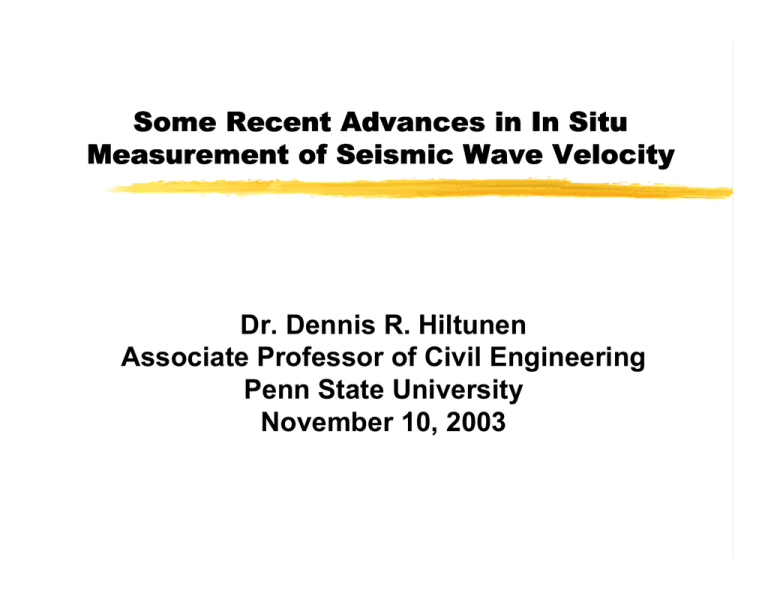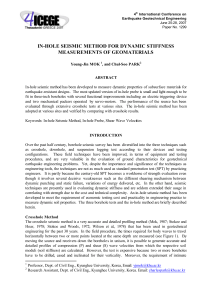Some Recent Advances in In Situ
advertisement

Some Recent Advances in In Situ Measurement of Seismic Wave Velocity Dr. Dennis R. Hiltunen Associate Professor of Civil Engineering Penn State University November 10, 2003 Topics !Tomography and evaluation of spatial variation !Liquefaction evaluation !Permanently installed, remotely operated test arrays Site Characterization Needs !Detailed characterization of foundation conditions !Detailed characterization of physical properties of tailings materials !Characterization of seismic hazards, e.g., ground motions, liquefaction evaluation Introduction ! Seismic wave propagation methods highly developed and accepted as engineering tool ! Borehole methods are nondestructive ! Surface methods non-intrusive and nondestructive Computer Spectrum Analyzer C1 C2 Source CL Vertical Receiver Vertical Receiver X/2 S X (Variable) Introduction ! Fundamental: produce elastic modulus via the relationship between modulus and propagation velocity ! Other parameters also possible: coefficient of lateral earth pressure, Poisson’s ratio ! Wide application: directly in design, quality control measure during construction, and diagnostic assessor after construction The SASW Method ! SASW = Spectral Analysis of Surface Waves ! Nondestructive, no boreholes ! Based on Rayleigh (surface) waves ! Determines detailed shear modulus versus depth profile of material ! Wide range of successful applications Spectral Analysis of Surface Waves Computer & Spectrum Analyzer Source Geophones X X X = 4, 6, 8, 12, 16 ft…. Power Source Equipment: Sources Equipment: Sources Equipment: Receivers Composite Site Profile Standard Penetration Resistance (SPT N-Value) Shear Wave Velocity (ft/s) 0 500 1000 1500 0 2000 2500 0 0 10 20 30 40 50 60 8 5 Soil Profile Clayey Sand 5 21 27 10 10 19 Depth (ft) 12 15 15 10 9 20 Sand 20 21 19 25 25 20 Clay assumed to continue to ~200' 30 30 45 35 35 SASW Seismic Crosshole Test !In situ, borehole test method from which a detailed seismic wave velocity profile can be determined !Seismic wave velocity determined via travel time between boreholes a known distance apart !Applicable to wide range of engineering materials: soil, aggregates, PCC, ACC Crosshole Schematic SH Wave SV Crosshole Test SV Source 3-D Receiver Response (volts) Response (volts) SV Time Records 10 0 Trigger -10 -20 0 0.02 0.03 0.04 2.E-02 1.E-02 5.E-03 0.E+00 -5.E-03 -1.E-02 0.05 0.06 0.07 0.08 0.09 0.1 1st Receiver 0 Response (volts) 0.01 0 01 0 02 0 03 0 06 0 07 0 08 0 09 01 ∆T = Interval Travel Time 0 04 0 05 0.04 0.05 4.E-04 2.E-04 0.E+00 2nd Receiver -2.E-04 -4.E-04 0 0.01 0.02 0.03 T ime (sec) 0.06 0.07 0.08 0.09 0.1 Crosshole Schematic SH Source: Mach 2 ODOT II-70 Standard Penetration Resistance (SPT N-Value) Shear Wave Velocity (ft/s) 0 500 1000 0 1500 2000 Soil Profile 2500 0 0 10 20 30 40 50 60 Fill 5 5 17 10 10 12 10 15 Clay 15 4 Depth (ft) 20 20 11 25 Sand 17 30 11 35 Clay 25 30 35 27 Sand 40 40 51 45 45 Shale 50 50 SV SH Applications ! Site characterization and foundation design for vibration-sensitive equipment: glass fibers, MRI, automobile components ! Earthquake liquefaction assessment: Vincent Thomas Bridge, VICC mine tailings impoundment Applications ! Site characterization for hazardous waste landfills: Ford Motor Co., Environmental Quality Corporation ! Assessment of soil/site improvement: DC Metro Subway, Bryce Jordon Center ! Characterization of highway and airfield sites: I-99, I70, Pensacola NAS, Sheppard AFB, Selfridge ANG Engineering Geophysics !Use methods adapted from seismological and petroleum industries for characterization of shallow subsurface ground conditions !Methods are analogous to medical techniques, e.g., X-ray, CAT scan, MRI !Enables “seeing” between boreholes or from instruments along the ground surface Medical Techniques CAT scan of human chest Engineering Geophysics !Do not “touch” actual material, but determine significant engineering parameters from geophysical measurements !Parameters such as seismic wave velocity and electrical resistivity are highly determined by material type and condition !Thus, can infer subsurface characteristics without actually touching material Geophysical Characterization of Bridge Foundation Sites in Karst ! Current site investigation practices for bridge foundations are inadequate ! Bridges in PA are often founded on piles or other deep foundations ! Highly variable subsurface conditions result in great uncertainty in deep foundation design Crosshole Test Results 10 ft 01 01 02 02 03 03 04 04 05 05 06 06 07 07 08 08 09 09 10 10 11 11 12 12 13 13 14 14 15 15 16 16 Crosshole Ray Shooting 30 ft V1=1000 ft/sec V2=7000 ft/sec V1=1000 ft/sec V2=3000 ft/sec V3=5000 ft/sec V4=7000 ft/sec P-Wave Tomogram Structure 318, Abut 1, PP-Wave Structure 318, Abut 1, SVSV-Wave Seismic Refraction Test !Measures first arrival times of seismic waves (P-waves) from the surface !Arrival times can be used to determine subsurface layer velocity and layer interface structure !Numerous CE applications - profiling top of bedrock - determining depth to bedrock Seismic Refraction Test Structure 319, Abutment 1 Structure 319, Pier 2 Electrical Resistivity !Electrical current is introduced into the subsurface through two electrodes while the voltage difference is measured with two other electrodes !Recent advances have made this method more widely used !Works well in karst terrane where there is a striking contrast between the carbonate rock and moist clayey soil overburden Electrical Resistivity Structure 318, Abutment 1 Resistivity Test #3 Soil Profile Sandy Silt with Clay 5 10 Depth (feet) 0 Sandy Clay/ Dolomite Frag. South North T o pso il -10 Silt with Sand -20 Silt/Clay/ Dolomite Frag. -30 20 Clayey Sand/ Dolomite Frag. 40 60 80 100 120 Silt/Sand/ Dolomite Frag. 200 100 50 25 12 0 Resistivity (Ohm-ft) 0 5 10 15 140 Distance (feet) 15 20 Soil Profile 20 25 Silt with Dolomite Frag. 30 25 Dolomite 35 30 Dolomite 40 45 35 50 End of Boring at 39.0' End of Boring at 51.0' Structure 319, Pier 2 Resistivity Test #7 Soil Profile Unsampled 5 Depth (feet) 0 Dolomite/Clay West East Soil Profile T o pso il -10 0 5 -20 Silt/Sand/Clay 10 20 30 40 50 10 60 70 80 90 100 10 Distance (feet) 15 3200 1600 800 400 200 100 50 25 12 0 15 20 Resistivity (Ohm-feet) Limestone 25 20 Limestone 30 25 35 40 30 End of Boring at 31' End of Boring at 41' Liquefaction Evaluation Uses and Limitations ! Vs and liquefaction similarly influenced by same factors, e.g., e, stress, age ! Fundamental mechanical property ! Measurements possible in hard-to-sample soils, e.g., gravels ! Can be determined without boreholes ! Usually measured for site response studies ! Same parameters can be measured in laboratory ! No samples, can miss thin layers, small strain Vincent Thomas Bridge Vincent Thomas Bridge Test Site A Shear Wave Velocity (fps) 0 200 400 0 5 Depth(ft) 10 15 20 25 30 35 SV SH 600 800 Shear Wave Velocity 0.7 Cyclic Stress Ratio (CSR) 0.6 0.5 0.4 0.3 Liquefaction 0.2 No Liquefaction 0.1 0 50 75 100 125 150 175 200 225 Overburden Stress-Corrected Shear Wave Velocity, V s1 (m/s) Mag 7.25 AV AH BV BH 250 Coal Refuse Impoundment Shear Wave Velocity Profile Shear Wave Velocity (fps) 0 600 0 500 400 20 300 Depth (ft) Phase Velocity (fps) 700 200 100 0 40 60 80 0 20 40 60 Frequency (Hz) 80 100 100 200 400 600 800 1000 1200 Permanent, Remotely Operated Test Arrays ! Rapidly improving availability of advanced testing hardware ! Wireless transducers, repeatable sources, PC-based data loggers, satellite modems ! Instruments can be operated and monitored via web ! Passive installations: monitor critical response parameters, e.g., deformation, pore water pressure ! Active installations: remotely determine important physical property, e.g., shear wave velocity Thank You!


